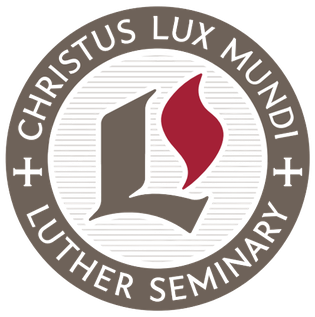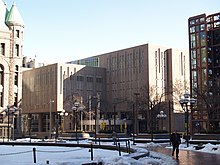
The Lutheran Church – Missouri Synod (LCMS), also known as the Missouri Synod, is a traditional, confessional Lutheran denomination in the United States. With 1.8 million members, it is the second-largest Lutheran body in the United States. The LCMS was organized in 1847 at a meeting in Chicago, Illinois, as the German Evangelical Lutheran Synod of Missouri, Ohio, and Other States, a name which partially reflected the geographic locations of the founding congregations.
The Evangelical Lutheran Church in America (ELCA) is a mainline Protestant Lutheran church headquartered in Chicago, Illinois. The ELCA was officially formed on January 1, 1988, by the merging of three Lutheran church bodies. As of 2021, it has approximately 3.04 million baptized members in 8,724 congregations.
The Synod of the Norwegian Evangelical Lutheran Church in America, commonly called the Norwegian Synod, was founded in 1853. It included churches in Illinois, Iowa, Minnesota, and Wisconsin.
The Lutheran Free Church (LFC) was a Lutheran denomination that existed in the United States, mainly in Minnesota and North Dakota, from 1897 until its merger into the American Lutheran Church (ALC) in 1963. The history of the church body predates its official organization, and a group of congregations that did not join the ALC formed the Association of Free Lutheran Congregations.
1517 Media, formerly Augsburg Fortress Press, is the official publishing house of the Evangelical Lutheran Church in America (ELCA). It also publishes for the Evangelical Lutheran Church in Canada as Augsburg Fortress Canada. Headquartered on South Fifth Street in Minneapolis, Minnesota, in the former headquarters of the American Lutheran Church, Augsburg Fortress publishes Living Lutheran, the Lutheran Book of Worship (1978), the Lutheran Study Bible, and Evangelical Lutheran Worship (2006), as well as a range of academic, reference, and educational books. Tim Blevins has served as the CEO of 1517 Media since August, 2018. Beth Lewis served as the CEO of Augsburg Fortress since September 3, 2002.
The Association of Evangelical Lutheran Churches (AELC) was a U.S. church body that existed from 1976 through the end of 1987. The AELC formed when approximately 250 dissident congregations withdrew from the Lutheran Church–Missouri Synod (LCMS) in 1976, and ended as an independent body when it became part of the new Evangelical Lutheran Church in America (ELCA) on January 1, 1988.
The Lutheran Church in America (LCA) was an American and Canadian Lutheran church body that existed from 1962 to 1987. It was headquartered in New York City and its publishing house was Fortress Press.

The Evangelical Lutheran Synodical Conference of North America, often known simply as the Synodical Conference, was an association of Lutheran synods that professed a complete adherence to the Lutheran Confessions and doctrinal unity with each other. Founded in 1872, its membership fluctuated as various synods joined and left it. Due to doctrinal disagreements with the Lutheran Church–Missouri Synod (LCMS), the Evangelical Lutheran Synod (ELS) and the Wisconsin Evangelical Lutheran Synod (WELS) left the conference in 1963. It was dissolved in 1967 and the other remaining member, the Synod of Evangelical Lutheran Churches, merged into the LCMS in 1971.

Luther Seminary is a seminary of the Evangelical Lutheran Church in America (ELCA) in Saint Paul, Minnesota. It is the largest seminary of the ELCA. It also accepts and educates students of 41 other denominations and traditions. It is accredited by the Higher Learning Commission and the Association of Theological Schools. It also has theological accreditation through the ELCA as well as the United Methodist Church.
The United Evangelical Lutheran Church was one of the many denominations formed when Lutherans came to the United States from Europe. Originally known as the United Danish Evangelical Lutheran Church, the United Church merged with other Lutheran groups to form the American Lutheran Church in 1960, which endured until 1988.
The Augustana Evangelical Lutheran Church was a Lutheran church body in the United States that was one of the churches that merged into the Lutheran Church in America (LCA) in 1962. It had its roots among the Swedish immigrants in the 19th century.
The Evangelical Lutheran Church (ELC) was a Lutheran denomination that existed from 1917, when it was founded as the Norwegian Lutheran Church of America (NLCA), until 1960, when it joined two other church bodies to form the second American Lutheran Church.
The Lutheran School of Theology at Chicago (LSTC) is a seminary of the Evangelical Lutheran Church in America in Chicago, Illinois. LSTC is a member of the Association of Chicago Theological Schools (ACTS), a consortium of eleven area seminaries and theological schools. It shares the JKM Library and portions of its campus with McCormick Theological Seminary. LSTC is accredited by the Association of Theological Schools and regionally accredited by the Higher Learning Commission.
Trinity Lutheran Seminary at Capital University is an Evangelical Lutheran seminary in Columbus, Ohio.

The Norwegian Lutheran Church in the United States is a general term to describe the Lutheran church tradition developed within the United States by immigrants from Norway.
Johan Arnd Aasgaard was an American Lutheran church leader.
The Evangelical Lutheran Joint Synod of Ohio and Other States, commonly known as the Joint Synod of Ohio or the Ohio Synod, was a German-language Lutheran denomination whose congregations were originally located primarily in the U.S. state of Ohio, later expanding to most parts of the United States. The synod was formed on September 14, 1818, and adopted the name Evangelical Lutheran Joint Synod of Ohio and Other States by about 1850. It used that name or slight variants until it merged with the Iowa Synod and the Buffalo Synod in 1930 to form the first American Lutheran Church (ALC), 1930–1960.
The American Lutheran Church (ALC) was formed in 1930 from the merger of the three conservative Lutheran synods of German-American origin: The Evangelical Lutheran Synod of Iowa and Other States, established in 1854; the Lutheran Synod of Buffalo, established in 1845; and the Evangelical Lutheran Joint Synod of Ohio and Other States, established in 1818 from the Ministerium of Pennsylvania. The headquarters of the ALC were in Columbus, Ohio, which had been the headquarters of the Joint Synod of Ohio, the largest of the three synods.

St. John's Lutheran Church is a member congregation of the American Association of Lutheran Churches (AALC) in Pocahontas, Missouri.
David Walter Preus was an American Lutheran minister. He served as the last president/presiding bishop of the American Lutheran Church (ALC) from 1973 until that body merged into the Evangelical Lutheran Church in America (ELCA) in 1988.
Todd W. Nichol All These Lutherans (Minneapolis: Augburg Publishing House, 1986)





